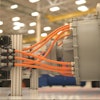OAKLAND, Calif. (AP) -- As engineers in California try to determine the cause of brittleness in steel rods that snapped on the new San Francisco-Oakland Bay Bridge, newly revealed documents show state transportation officials accused a bridge contractor of ordering the rods too late, forcing them to be tested and released simultaneously to keep the project on schedule, a newspaper reported.
The documents showing the clash between state transportation officials and contractor American Bridge/Fluor Joint Venture are among hundreds of pages of documents released by Caltrans last week, the San Jose Mercury News reported on Tuesday (https://bit.ly/11qX13R ).
Nearly three dozen of the 96 rods in question snapped earlier this year when crews tightened them. The rods connect steel earthquake safety devices called shear keys to the deck of the bridge and a large concrete cap.
At least some of the failed rods are located beneath that cap and cannot easily be replaced, state transportation officials have said. Finding a fix for them could take weeks or even months, which could delay the planned Labor Day opening of the new span.
Caltrans normally tests parts before allowing them to be shipped, the Mercury News reported. But in this case, the agency said American Bridge/Fluor ordered the parts too late.
A call to an American Bridge Fluor site office by The Associated Press on Wednesday was not immediately returned.
Bay Bridge spokesman Andrew Gordon said he could not address specific questions about the bolts' fabrication process.
In 2008, state transportation officials also admonished American Bridge Fluor and subcontractor, Dyson Corp., for delivering products that didn't meet specifications. Three weeks later, the state ordered an additional surface crack test on a list of critical steel fasteners, The San Jose Mercury News reported.






















